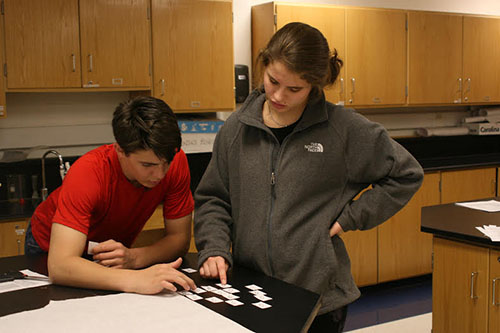S.T.E.M. biology students reconsider stereotypes through Cancer for the Common Good

While working in their biology class, Mike Hatfield and Abby Coleman perform a lab. Along with others, these S.T.E.M. juniors students took part in the project Cancer for the Common Good which shed new light on how to cure different diseases with cancer cells.
February 28, 2017
Imagine being given the opportunity to solve a biological issue or disease. Perhaps you would want to cure an illness that affects someone in your family, or maybe solve a problem that affects many people, such as allergies or the common cold. Junior STEM biology students were tasked with finding a solution to this problem using something that has been perceived as dangerous and deadly: cancer.
Aparna Puppala, science and STEM biology teacher, explains that the assignment, called Cancer for the Common Good, allowed students to use either a paper, presentation or program to present how they could theoretically create cancer in a certain cell line, and how that cancer could cure a disease or solve some kind of problem.
“I’ve been wanting to do a project where kids would have a lot of different options for how to show what they did,” Puppala said. “And it was important to me to give students an opportunity to show their mastery of the material in a bunch of different formats.”
Puppala said she admired how the students used their freedom to create a variety of unique projects. She recalls that topics ranged from using cancer in the pancreas to minimize the effects of diabetes, to using skin cell cancer to help heal burn victims, to making organ transplants easier.
“I was really impressed with the types of problems that students found,” Puppala said. “A lot of them were based on their own experiences and their own lives, […] or problems in the world that need to be solved.”
Lucas Pauler, junior STEM student, did his project on using leukemia, a cancer that exponentially increases the white blood cell count of a person, to increase the white blood cell count of people with immunodeficiencies such as AIDS. He used a computer program to present his project, which he said he enjoyed because he likes computer science and was able to improve his coding skills.
“My program has an interactive interface so you can adjust the different production rates and replication rates, which makes it even that much more interesting, and I can learn that much more with my project,” Pauker said.
Junior Athanacia Papoutsis, another junior STEM student, chose to write a paper on creating cancer in the photoreceptor cells in the rods and cones in the eye, which prevents a person from suffering from vision loss. This would restore vision in people with damaged or missing rods and cones. Papoutsis said that she appreciated an opportunity to use cancer for good.
“We see cancer as this horrible thing — and it still is most of the time — but trying to come up with a way that it isn’t terrible and can be useful was really interesting,” Papoutsis said.
Puppala admired how the students were engaged and invested in their projects. She said that students even worked over winter break to enhance their knowledge of new subjects and skills that they wanted to be more familiar with.
“I was so impressed that students got to learn something outside of what they are doing in my course and do more than just satisfy the requirements but to really go above and beyond,” Puppala said.


